The Conservancy’s summer stew crew ended a productive (and sweaty!) season with a meet and greet with Truist, which was responsible for funding their work through a Truist Charitable Fund grant. Brandon Tennis, Senior VP of Stewardship, answered some questions about the season, the work that was completed, and the impact of the initiative on both the Conservancy’s preserves and the stew crew members.
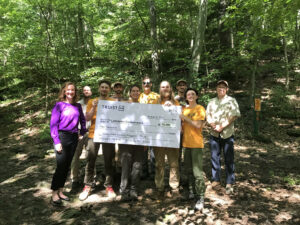
Sarah Lesser, Senior Vice President, Lancaster/Lebanon Market President for Truist (left), meets with the summer stew crew. Photo: Kelly Snavely
What impact has this crew had with the work they did this summer?
Within 2,400 total hours throughout 13 of the hottest weeks of the year, the Stew Crew helped implement roughly 75% of the Tucquan Glen & Pyfer Nature Preserves’ trail redesign while solving many design issues on the ground that simply could not be anticipated during the desktop phase of planning.
The Crew’s impact on the Conservancy’s preserves and the particpants has proven the success of the stewardship crew pilot program as a green-collar job training program funded by Truist. The Conservancy fully anticipates running the program again in 2023 to continue to support the development of our Stewardship program in both habitat and passive recreation initiatives.
How have you seen the crew grow throughout their experience?
The conditions and use of the Tucquan Glen & Pyfer Nature Preserve’s trail system has been an issue for over a decade. A feasible design solution to reduce stream crossings, reroute out of floodplains, improve conditions of existing trails for access and safety, implement new trail standards, plan for emergency access, and armor restoration areas and sensitive habitats has been a difficult puzzle to solve. In implementing the redesign project this crew is leaving their own legacy behind with an improved trail system that will last 50+ years… talk about a conservation win and resume builder! I’ve directly observed the crew’s pride in their work and their pursuit of a career in conservation. I’ve also observed each crew member’s personal understanding of conservation across scale as they experienced their work as a part of a larger regional initiative.

The stew crew hikes to their work site on a newly formed trail. Photo: Aaron Egy-Good
What do you hope the crew has taken away from this summer – especially as it relates to future “green” conservation careers?
The intentions have always been for the crew to gain experience, garner new skills, learn directly from seasoned and highly skilled staff, connect with conservation partners, feel a part of the organization and find a home in conservation, while developing a competitive resume and pay wage; with the hope that they continue their education in conservation, start their career in conservation, work within and grow conservation locally, and seek employment at either a partnering organization or work with the Conservancy again when opportunities become available.
We also asked each member of the summer stew crew to share with us a favorite memory (or two!) and a favorite photo from their summer on the preserves.
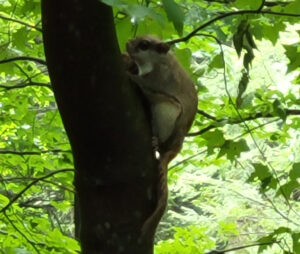
A southern flying squirrel. Photo: Mark Roberts
AARON EBY-GOOD: One special moment we got to experience was seeing a Southern Flying Squirrel! We were working right next to the snag the squirrel had built its nest in, and it glided down past us to another tree. I didn’t even know that we had flying squirrels in the forests here! We spent the rest of the day keeping an eye out for it and got a few more sightings. More than one single memory though, I’ll remember foggy mornings listening to the birds singing in the glen, learning new plants, animals, and fungi, getting to know my coworkers, and how happy and refreshed working all day in the forest made me!
This summer really cemented for me that this is a field I want to build my career in. I was surprised by how rewarding the work was, and how fulfilled I felt. It was amazing to be able to see the progress we made each day in such a tangible way, and I enjoyed talking to folks hiking through, seeing the people who benefit directly from the work we’ve done. I learned a lot about trail building and career directions in conservation, but the most meaningful thing to me was learning how passionate I am about this work and the Lancaster Conservancy’s goals.
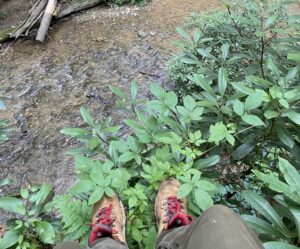
Sitting on a rock outcrop , overlooking trail work. Photo: Ian Batchelor
IAN BATCHELOR: To name only a few favorite memories is difficult, as there are so many to choose from. Ones that standout are the crew spotting and pointing out different wildlife as well as cool relics such as snakeskins, animal skulls, fantastic fungi and many more on a daily basis (and sometimes much more frequently). Additionally, seeing all the hikers who visit Tucquan Glen and are thankful for the work we do was a bright spot on every occasion. A particularly funny moment was on a rainy day doing trail work in somewhat difficult conditions, hearing voices approaching speaking Pennsylvania Dutch, and discovering it was a group of 10-15 Amish schoolchildren as young as 8-9 wearing their usual dress, pants, and nice shoes while using our trails. A final memory I will carry with me from this summer is of a black/white spotted duck, owned by one of the neighbors of Tucquan, who made a nest at the trailhead and was always waiting for us each morning and afternoon on our hikes in and out of the glen, either in its nest or floating in the stream.
Working closely with all the different members of the Conservancy’s land protection and stewardship department as well as hearing those from other departments speak about their work and job functions at all-staff meetings has shown me the variety of experience, backgrounds and specialties needed in order to help an organization of this magnitude run smoothly and effectively. This has helped prepare me for a potential green career by showing me that there is not just one avenue into this line of work and I have the option to explore a niche (or several) in which my interests and abilities can be best utilized in a team setting.
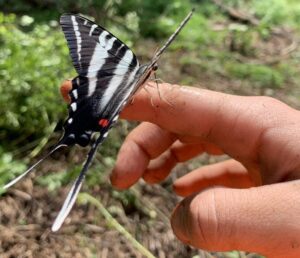
Enjoying a visit from a swallowtail butterfly. Photo: Jerilyn Lapp
JERILYN LAPP: Pushing through the heat and physical challenges this summer has taught me to trust my own strength and abilities. I loved finding so many new species of plants and critters this summer, including a flying squirrel and Black Widow spider. It was also fun to run around with our crew mascot, Trigger (forester Eric’s pup).
Working with the Conservancy showed me first-hand the ups and downs of implementing plans for erosion control, outdoor safety, and preservation, which gives context to the broader ecological concepts I am learning in school. It has also been invaluable to learn daily from the stewardship team about species identification, career advice, different approaches to conservation, and much more. The job has confirmed my passion for a career in conservation, through experiencing the rewards of helping repair degraded natural systems and the adventures of working in nature full-time.
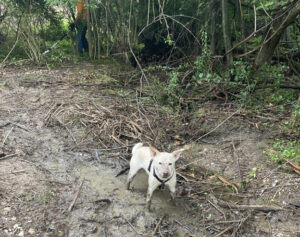
Forester Eric Roper’s dog Trigger, enjoying a dip in a mud puddle. Photo: Matthew Lebel
MATTHEW LEBEL: From all the falling in the creek, ripping of pants, and Trigger the dog laying in various mud puddles, there are so many great and funny memories from this summer to choose from. I’d probably say the best was not one in specific, but just all the lunches the crew and I had in different and beautiful natural places. From sitting in the creek to overlooking the Susquehanna, not even having to say anything, just the presence of others and the location made amazing memories.
As mentioned by many others before, learning how to implement conservation rather than just studying textbooks is vitally important when finding green career opportunities and understanding the positions. This has made me feel so much more confident that no matter what I do in life, I want to continue being in the field and working outdoors and making the world a better place for its inhabitants of all sizes and species.
